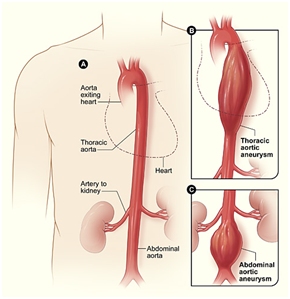Visit and Join the WeHeal Aortic Aneurysm
For more information, see: CDC Aortic Aneurysm Fact Sheet | Wikipedia

An aortic aneurysm is a balloon-like bulge in the aorta, the large artery that carries blood from the heart through the chest and torso. Aortic aneurysms work in two ways:
- The force of blood pumping can split the layers of the artery wall, allowing blood to leak in between them. This process is called a dissection.
- The aneurysm can burst completely, causing bleeding inside the body. This is called a rupture.
- Dissections and ruptures are the cause of most deaths from aortic aneurysms Aortic Aneurysm in the United States
- Aortic aneurysms were the primary cause of 10,597 deaths and a contributing cause in more than 17,215 deaths in the United States in 2009.
- About two-thirds of people who have an aortic dissection are male.
- The U.S. Preventive Services Task Force recommends that men aged 65–75 years who have ever smoked should get an ultrasound screening for
abdominal aortic aneurysms, even if they have no symptoms.
Types of Aortic Aneurysm
Thoracic Aortic Aneurysms
A thoracic aortic aneurysm occurs in the chest. Men and women are equally likely to get thoracic aortic aneurysms, which become more common with
increasing age.
Thoracic aortic aneurysms are usually caused by high blood pressure or sudden injury. Sometimes people with inherited connective tissue disorders, such as Marfan syndrome and Ehlers-Danlos syndrome, get thoracic aortic aneurysms.
Signs and symptoms of thoracic aortic aneurysm can include
- Sharp, sudden pain in the chest or upper back.
- Shortness of breath.
- Trouble breathing or swallowing.
Other Types of Aneurysms
Aneurysms can occur in other parts of your body. A ruptured aneurysm in the brain can cause a stroke. Peripheral aneurysms—those found in arteries other than the aorta—can occur in the neck, in the groin, or behind the knees. These aneurysms are less likely to rupture or dissect than aortic aneurysms, but they can form blood clots. These clots can break away and block blood flow through the artery.
Visit and Join the WeHeal Aortic Aneurysm
For more information, see: CDC Aortic Aneurysm Fact Sheet | Wikipedia
WeHeal is very grateful to our valued sources of information which include Wikipedia, WebMD, ClinicalTrials.gov, Cancer.gov, Infoplease, and the US CDC (Center for Disease Control).